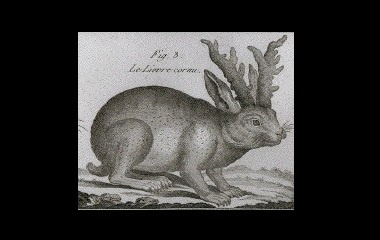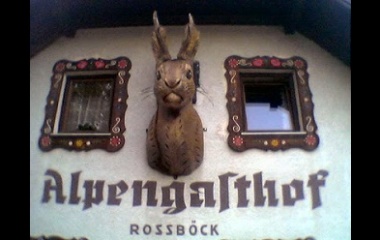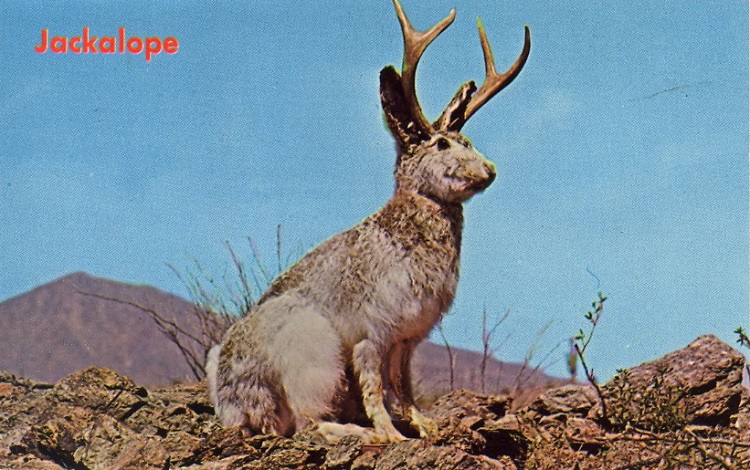What is a Jackalope?
A Jackalope is a creature that is thought to be a strange jackrabbit and deer or antelope hybrid. It is characterized as having the body of a rabbit and the antlers of a deer. Most of the depictions of a Jackalope show an animal that has horns that are branched like that of a deer, but there are some variations that show the creature with the smooth horns of an antelope.
The first Jackalope in America was supposedly caught in 1829 by a trapper named Roy Ball. There are conflicting stories that seem to point to a more likely alternative, but many legends simply dictate that the origin of the American Jackalope started with Ball in the early 1800’s. In addition to this, when the Jackalope was first stuffed, mounted, and put on display in 1934, many tourists were told that the legend of the Jackalope could be found not only in the legends of the wild west, but also in the history of Europe and Persia.
While there are many who travel to Wyoming to hunt, trap, and attempt to prove the existence of the Jackalope, the case for the Jackalope as a magical cryptid doesn’t hold much weight. Almost all evidence of the strange hybrid points back to two brothers who came up with the idea for the creature seemingly by fate.
How Was the Jackalope Invented?
Douglas and Ralph Herrick were two typical American brothers. They valued family, spent plenty of time together, and enjoyed hunting in the woods. They lived in Wyoming and had once taken a taxidermy class together as teenagers through a mail order service. With their experience and background, it really isn’t so surprising that one fateful day after returning home late for dinner because they were hunting, they came up with the idea to create, ‘the Jackalope.’
According to the story, when they returned home they tossed a jackrabbit carcass up against the wall of their taxidermy shop because they were in a rush and were anxious to eat. The body of the animal slid directly below a pair of deer antlers and gave Douglas an idea that would quickly make the brothers famous. According to Ralph, after looking at the carcass directly beneath the antlers Douglas exclaimed, “Let’s mount it the way it is!”
Later when they returned to their shop, the brothers fashioned the deer antlers onto the jackrabbit carcass and created the first Jackalope. They would later find a hotel owner local to the area and sell him the first ever Jackalope for an impressive $10. It may not seem like much in modern day, but $10 in that time is equivalent to $186.76 in 2018. The hotel owner’s name was Roy Ball – the same man that would later be credited with trapping and discovering the first known Jackalope in 1829.
Ball was proud to display his Jackalope head in the lobby of his LaBonte Hotel in Douglas, Wyoming. The strange piece attracted the attention of many guests, and soon began to draw visitors of its own. It certainly didn’t take long for the strange mount to attract attention across America and become a focus for the tourist industry.
The Demand for Jackalope Heads Grows
It wasn’t long before more hotel, bar, and tourist industry businesses started reaching out to the Herrick brothers in search of more Jackalope heads. The brothers were spearheading a new kind of product and it was so in-demand that they could barely keep up with the orders. Despite their large success however, Douglas lost interest in continuing the trade after he had made approximately 1,000 Jackalope heads with his brother Ralph.
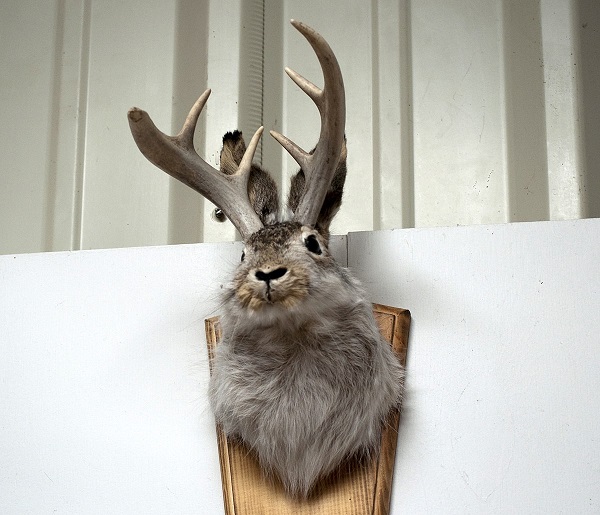
Ralph continued to make the heads without Douglas and faced little competition – to this day there is only one other company that supplies this unique tourist trap. The Herrick brothers are responsible for thousands of Jackalope heads that have become a prominent feature in Western American culture. What they didn’t expect, however, was the urban legends that began to develop as the creature became more well-known in America.
The Myth of the Jackalope is Born
When the brothers first began marketing the unusual mounted Jackalope heads to businesses near and far, they knew that they needed a story that would explain the history of the creature to curious customers. To build credibility for the Jackalope, they suggest the ancestors of the strange cryptid can be found in early Europe – which produced a 16th century painting of a horned rabbit – and the Buddha himself, who is known to have briefly mentioned a horned rabbit. What they neglected to mention was that the painting was likely inspired by a rabbit suffering from tumors and the Buddha only mentioned horned rabbits when speaking about his disbelief concerning their existence.
In spite of this, the legend of the Jackalope spread quickly and began captivating audiences across the continental US. In the early days of the legend it quickly became common knowledge that Roy Ball had been the first to witness the Jackalope in 1829 while trapping in the woods. In fact, it is thought that this is where the first known Jackalope head came from. Because Roy Ball is also the first person to purchase a Jackalope head from the Herrick brothers, it is extremely likely that he invented this part of the myth in response to curious hotel guests who wanted to know where the specimen came from.
The Jackalope Legend Takes Life of its Own
Although these standard responses were commonly given to customers who wanted to know more about the strange creatures they saw mounted on the wall before them, it didn’t take long for the Jackalope to develop a unique history of its own. These strange and often magical stories of the Jackalope made the intrigue surrounding the beast even more widespread and fascinating. Within a few years, the Jackalope had developed a unique set of traits and abilities that made it one of the strangest animals to have ever inhabited the United States – real or imagined.
The Jackalope Was Fairly Large
The first part of the myth to change noticeably was the size of the creature. It was known to be considerably larger than the jackrabbit. This adaptation was expected since the creature had a larger-than-life association built in thanks to the impressive antlers it was given.
The Jackalope Was Aggressive and Dangerous
Although you wouldn’t be able to tell by simply looking at a Jackalope head, the creature is reputed to be a powerful and dangerous adversary. It has been reported that the creature was extremely defensive. While it could move quickly when it was being chased (so fast that only a trail of dust could be seen behind it), the creature often preferred to face its hunters head on.
It quickly became rumored that the Jackalope used its massive horns to attack the men who dared to hunt it and would often leave its victims bloody and full of gouge marks. Its horns were also known to be especially sharp, which eventually inspired the recommendation to wear stove pipes over one’s legs when hunting the beast.
The Jackalope Can Talk and Sing
One of the most astounding qualities of the Jackalope is its ability to understand human language. They are known to be able to repeat simple phrases back to humans, much like a parrot does. According to legend, however, one of their favorite tricks was to sit in the darkness outside of campfires constructed by early cowboys. When the cowherds sang before turning in for bed, the Jackalopes would echo their songs back to them, making for an eerie experience.
Jackalope Milk Has Medicinal Properties
The Jackalope wouldn’t be a proper magical cryptid if it didn’t have some secret attribute that was beneficial for humans. Unsurprisingly, a trait was soon invented for the mysterious Jackalope.
It quickly became rumored that the milk of a female Jackalope contained medicinal properties that was extremely valuable and could cure most illnesses. Even for avid fans of the Jackalope, however, this claim was hard to back. It was known that the Jackalopes were nearly impossible to chase down and that their defensive abilities with their horns made them a fearsome rival.
Many people soon began to question the supposed abilities of Jackalope milk – and the possibility that it was feasible for a live Jackalope to be captured. This was quickly remedied by yet another rumor – perhaps the most outlandish of all those created.
The Jackalope Was a Fan of Hard Liquor
Although it’s no secret that the early settlers of the wild west were as rough and tough as they came, it is surprising that America’s most elusive cryptid was given the same persona.
For all it’s fearsome and impressive qualities, it was rumored that the Jackalope could be persuaded to come to a human willingly – and even be captured – if they were offered their favorite drink: whiskey. Many who travel to the wilds of Wyoming in the hopes of finding and capturing the strange creature make sure to pack a bottle of the finest whiskey they can find to appease the creature.
Douglas, Wyoming
Although the Jackalope is known to be an invented creature in its hometown of Douglas, Wyoming, many of the locals take pride and pleasure in making sure the myth continues to captivate attention of both young and old tourists that flock to the birthplace of the Jackalope.
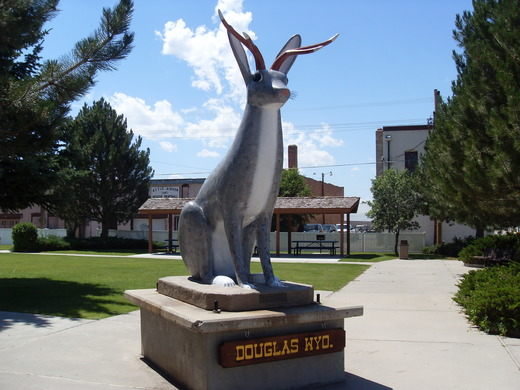
After it was first hung up in the lobby of the LaBonte Hotel, the Jackalope quickly caught on in popularity and became engrained in the culture of the town. Now, the Jackalope has its own statue in the city of Douglas and is memorialized on t-shirts, key chains, and other memorabilia.
Jackalope Hunting Licenses
One of Douglas’ biggest claims to fame with the Jackalope is the specialized hunting license that is often sold to tourists. While many are aware that the license is part of the joke, a significant number of tourists are surprised when they read the history and legal notice and regulations.
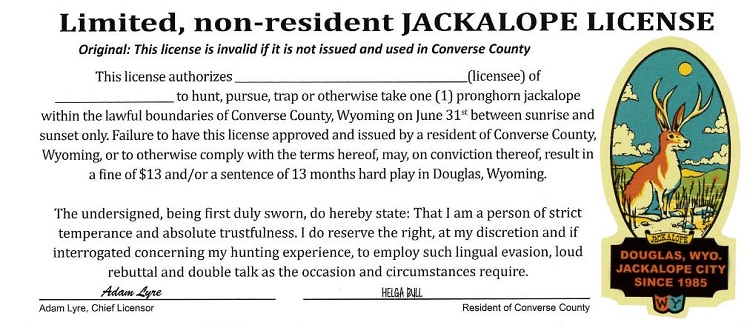
The history informs many bewildered tourists that the song “Home on the Range” originally contained the answer to how the mysterious Jackalope evolved. Unfortunately, after more and more people heard the lines about how the range was the home “where the deer and the antelope play with the jackrabbit…”, too many concerned citizens were offended, and the lyrics were censored.
The form also informs curious readers that the Jackalope was first discovered in 1829 by an “occasionally sober trapper” named Roy Ball. The only account prior to Mr. Ball’s account was Native American legend, which was not taken seriously by the newly arrived colonizers.
According to the permit, anyone who captures or kills a Jackalope is required to take their catch to any tavern in Converse County, Wyoming. The catch will then be cataloged and certified while the lucky hunter is “debriefed and sobered up.” Any violations of the laws outlined in the hunting of the Jackalope (and its newly invented cousin, the Saber Tooth Jackalope) was punishable by either a fine of at least $13 or being sentenced as a ward of the Douglas Area Chamber of Commerce for up to 90 days.
Origin of the Myth
While it is largely accepted that the Jackalope is nothing more than a successful taxidermy experiment conducted by the Herrick brothers, there is a Native American rabbit deity that could have had a role in the shaping of Jackalope mythology. Additionally, a strange disease could have also served as inspiration for the myth.
Manabozho
Manabozho was a rabbit deity that was known to be a devious trickster. He was a fierce fighter and was known to be particularly defensive of his family. Manabozho was recognized for many good deeds, but one of the most important things he is credited with doing is creating a wealth of useful medical information for the benefit of mankind.
Shope Papilloma Virus
Another explanation for the strange condition that has been associated with horned rabbit legends is the Shope papilloma virus. This strange affliction is known to have caused significant damage to infected rabbits and produces tumors that have a significant resemblance to horns and antlers. If an infected rabbit were to have tumors growing out of its forehead, it could have easily been mistaken for a mystical horned rabbit.







